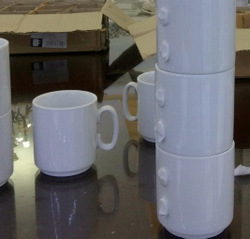Breakage at rinsing

Sink breakage - annoying, but avoidable
The scullery is usually the poor relation in kitchen planning and is given by far the least space in terms of the throughput of all moving parts in the catering area. Sculleries are usually cramped and the rush hour is like a war. Waiters "shoot" the dishes onto the pass, plates pile up on bowls and dishes, cups and saucers clatter in the middle and an organised process is hardly possible. Once the dishes have finally been washed - and are often not even really dry yet - they are stacked and stacked again.
Conventional household porcelain and ceramics cannot cope with such conditions. This is why there are specialised manufacturers, such as Holst Porzellan, who produce hard porcelain of the "semi-strong body" or "hotel porcelain" quality class. However, even these stronger crockery items can show signs of damage under commercial washing loads due to mechanical effects that occur above the intended use.
A sensitive moment for such dish breakage is the operation after removing the cleaned, hot porcelain from the dishwasher. Drying processes take place above 90 °C and the heated crockery enters the cooling process. The thermal effects on the body and glaze are slightly different, as the glaze as a surface cools faster than the inner body. The porcelain body is under natural tension immediately after rinsing and thermal drying and is particularly susceptible to breakage during this phase.
If the crockery is placed "roughly" in stacks or baskets during this temperature equalisation, this additional mechanical load has an aggravating effect on the body and glaze and can quickly lead to breakage in this combination. Even well-defined stacking edges are often unable to withstand this impact and the porcelain breaks. The typical characteristics of sink breakage are
- Breaking handles and snaps
- Chipping of mouth margins
- Chipped edges
In the case of such damage, the porcelain is often assumed to have a production fault or be of poor quality. However, an expert can easily distinguish a production defect from a normal sink break. Rinsing fractures, e.g. of handles, snaps and edges, are characterised by an irregular, rough fracture and thus differ from very straight stress fractures, which can result from a disturbance in the cooling process during the manufacture of the porcelain.
Caution: Risk of injury if the sink breaks!
Product knowledge - A request to our readers!
Since 1998, we have been cultivating our product knowledge out of a passion for porcelain and the endeavour to share our knowledge about this beautiful and exciting material. In more than 20 years, our information pages have grown into a free online encyclopaedia of porcelain knowledge and now serve dealers, end customers, vocational schools and even competitors as a helpful reference work. In times of increasingly important reviews on the Internet, we therefore ask you to write us a small review on Google. This will help us to address topics that have not yet been dealt with and to constantly revise this knowledge database. Thank you very much.

